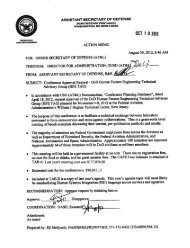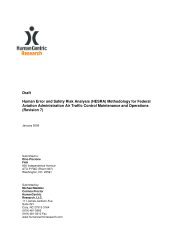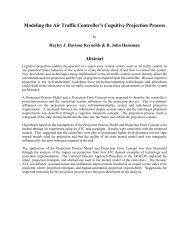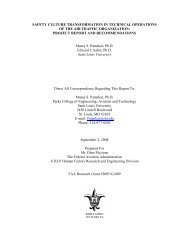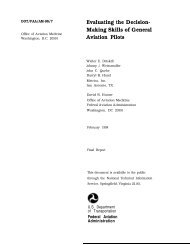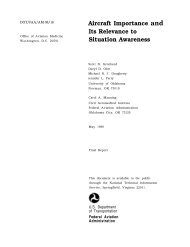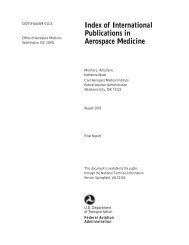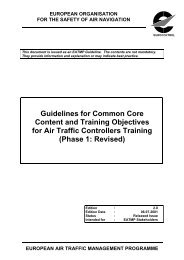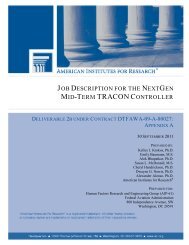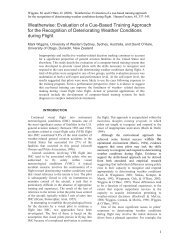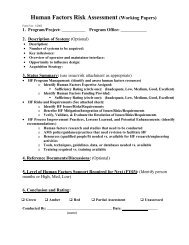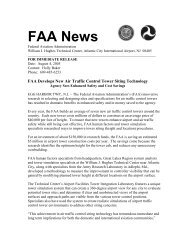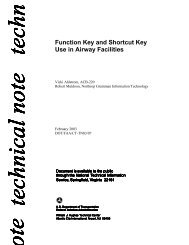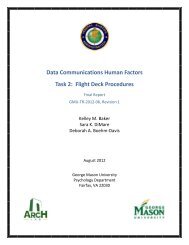job description for the nextgen mid-term atct controller - FAA Human ...
job description for the nextgen mid-term atct controller - FAA Human ...
job description for the nextgen mid-term atct controller - FAA Human ...
You also want an ePaper? Increase the reach of your titles
YUMPU automatically turns print PDFs into web optimized ePapers that Google loves.
status and in<strong>for</strong>mation areas (SIAs), in<strong>for</strong>mation contained on <strong>the</strong> Automated Terminal<br />
In<strong>for</strong>mation Service (ATIS), flight strips, and <strong>the</strong> alphanumerical data blocks of <strong>the</strong> surface<br />
surveillance systems, such as Airport Surface Detection Equipment-Model X (ASDE-X),<br />
Automated Radar Terminal System (ARTS), Common Automated Radar Terminal System<br />
(CARTS), or Standard Terminal Automation Replacement System (STARS). Once initial<br />
assessments have been made, <strong>controller</strong>s follow position relief checklists and use sign-in logs to<br />
complete <strong>the</strong> transfer of control. After assuming <strong>the</strong> position, <strong>controller</strong>s adjust <strong>the</strong> displays,<br />
volumes, and configurations, if necessary, to ensure that all are satisfactory and usable.<br />
During <strong>the</strong>ir work period, <strong>controller</strong>s scan and monitor airport surveillance radar systems, flight<br />
strips, wea<strong>the</strong>r data, aircraft and vehicle positions, and equipment status monitors (alarms) to<br />
establish overall awareness of <strong>the</strong> operation. ATCT line <strong>controller</strong>s use all in<strong>for</strong>mational sources<br />
to identify patterns and irregularities, not only within <strong>the</strong>ir area of responsibility but also in<br />
adjacent areas, on <strong>the</strong> airport, and within <strong>the</strong> National Airspace System (NAS) as a whole.<br />
The final step of maintaining situation awareness occurs as <strong>controller</strong>s are relieved from <strong>the</strong>ir<br />
positional duties. At this time, <strong>the</strong>y pass all previously ga<strong>the</strong>red in<strong>for</strong>mation to <strong>the</strong> next<br />
<strong>controller</strong>. This protocol ensures that <strong>the</strong> next <strong>controller</strong> can also establish and maintain situation<br />
awareness and provide uninterrupted service to users. Both <strong>controller</strong>s must review in<strong>for</strong>mation<br />
<strong>for</strong> completeness and accuracy as <strong>the</strong>y incorporate it into <strong>the</strong>ir position relief briefing using<br />
recorded lines and position checklists. An acceptable exchange is completed as <strong>the</strong>y fill out and<br />
sign <strong>the</strong> position logs.<br />
The purpose of establishing and maintaining situation awareness is to give ATCT line <strong>controller</strong>s<br />
<strong>the</strong> means to operate <strong>the</strong>ir position while still being able to consistently manage operations and<br />
communicate effectively with o<strong>the</strong>rs. This communication is covered in <strong>the</strong> next Activity.<br />
Current ATCT Activity 2: Manage Communications<br />
Controllers working in <strong>the</strong> ATCT environment control <strong>the</strong> movement of aircraft and vehicles—<br />
and ensure <strong>the</strong>ir separation—primarily by communicating clearances and o<strong>the</strong>r instructions to<br />
o<strong>the</strong>rs. In<strong>for</strong>mation vital to <strong>the</strong> operation of <strong>the</strong> NAS is contained in this constant flow and<br />
exchange of in<strong>for</strong>mation.<br />
More specifically, ATCT line <strong>controller</strong>s are responsible <strong>for</strong> establishing, maintaining,<br />
transferring, and <strong>term</strong>inating two-way communications with operators as well as with o<strong>the</strong>r<br />
<strong>controller</strong>s and facilities. Controllers use radio frequencies and landlines that are part of <strong>the</strong><br />
Rapid Deployment Voice Switch (RDVS) or <strong>the</strong> Enhanced Terminal Voice Switch (ETVS).<br />
After initial contact is established, <strong>controller</strong>s <strong>for</strong>mulate clearances, instructions, and o<strong>the</strong>r<br />
messages by following a specific protocol of initiating, receiving, and verifying in<strong>for</strong>mation <strong>for</strong><br />
accuracy. If updates or amendments are needed, <strong>controller</strong>s ensure communications integrity by<br />
completing <strong>the</strong>m in a timely manner.<br />
Communications provide <strong>the</strong> key link to air traffic control system functionality. Each<br />
component of this system must be relayed in a complete, timely, and accurate manner to ensure<br />
<strong>the</strong> smooth, safe flow of air traffic and to allow o<strong>the</strong>r important in<strong>for</strong>mation to be relayed.<br />
Responsibilities regarding flight plan data are covered in <strong>the</strong> next section.<br />
20



